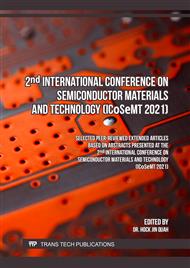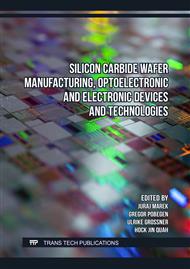p.51
p.57
p.67
p.73
p.79
p.87
p.93
p.99
p.105
Fabrication of Nanocomposite PDMS/Graphene as Flexible Substrate at Different Graphene Volume
Abstract:
Conductive and flexible electronics have attracted great demands and attention in the field of stretchable and wearable electronic devices. In this work, polydimethylsiloxane (PDMS) was composited with different drops of graphene solution to produce flexible, conductive and optically transparent PDMS/Graphene composite using the drop-cast method. The dielectric constants of PDMS and PDMS/Graphene composite were measured using Agilent dielectric probe. I-V characterization was used to measure the conductivity of the flexible substrate in flat and bending conditions. The UV-VIS was used to measure the transmittance properties of the substrate. Comparing the electrical properties of the pristine PDMS substrate with graphene composited PDMS substrates, the current shows a slight decrease due to the physical morphology of PDMS/Graphene composite that creates a small hole on the surface. No significant changes can be found between 1 drop, 2 drops, 3 drops and 4 drops of graphene in PDMS solution. For the dielectric measurement, the result of composited PDMS/Graphene sample had shown a lower value of dielectric constant (1.1 F/m) compared to pure PDMS (2.33 F/m). This shows that the existence of graphene in PDMS reduces the dielectric constant of pristine PDMS. The result of UV-VIS shows the samples with 4 drops of graphene having the lowest visible transmittance. The PDMS/Graphene composite can be concluded as a dielectric material with a lower dielectric constant. It has the potential to be used as a conductive substrate for further flexible interconnect materials since it has a unique electrical feature and robust mechanical strength.
Info:
Periodical:
Pages:
79-84
Citation:
Online since:
May 2023
Keywords:
Price:
Сopyright:
© 2023 Trans Tech Publications Ltd. All Rights Reserved
Share:
Citation:



